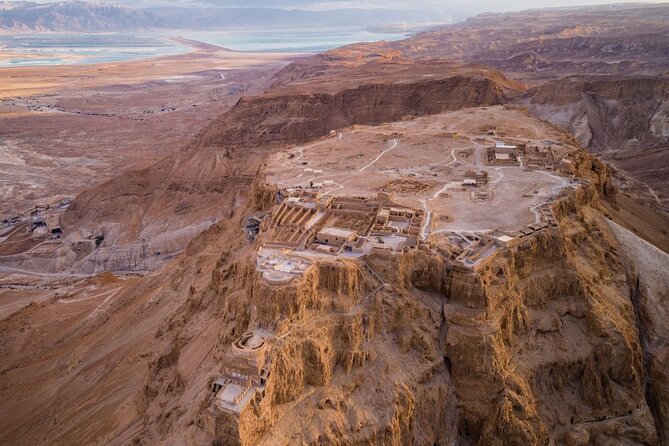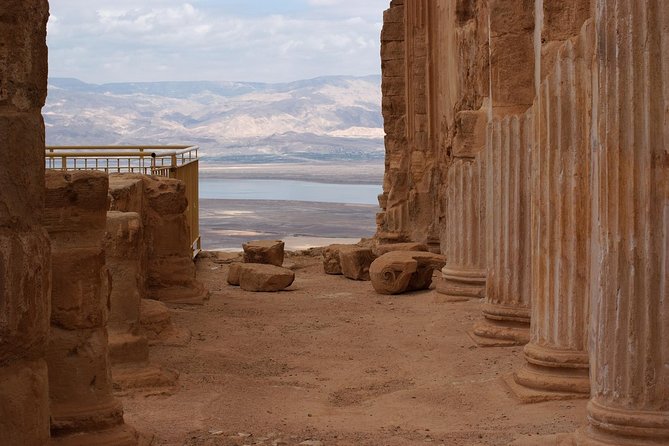Masada (Hebrew: מצדה metsada, "fortress") is an ancient fortification in the Southern District of Israel situated on top of an isolated rock plateau, akin to a mesa. It is located on the eastern edge of the Judaean Desert, overlooking the Dead Sea 20 km (12 mi) east of Arad. Herod the Great built two palaces for himself on the mountain and fortified Masada between 37 and 31 BCE. According to Josephus, the siege of Masada by Roman troops from 73 to 74 CE, at the end of the First Jewish–Roman War, ended in the mass suicide of the 960 Sicarii rebels who were hiding there. Masada is one of Israel's most popular tourist attractions. The cliff of Masada is, geologically speaking, a horst. As the plateau abruptly ends in cliffs steeply falling about 400 m (1,300 ft) to the east and about 90 m (300 ft) to the west, the natural approaches to the fortress are very difficult to navigate. The top of the mesa-like plateau is flat and rhomboid-shaped, about 550 m (1,800 ft) by 270 m (890 ft). Herod built a 4 m (13 ft) high casemate wall around the plateau totalling 1,300 m (4,300 ft) in length, reinforced by many towers. The fortress contained storehouses, barracks, an armory, a palace, and cisterns that were refilled by rainwater. Three narrow, winding paths led from below up to fortified gates. Almost all historical information about Masada comes from the first-century Jewish Roman historian Josephus.

Masada Tours and Tickets
🎧 No audio guides are available in this language.
Masada (Hebrew: מצדה metsada, "fortress") is an ancient fortification in the Southern District of Israel situated on top of an isolated rock plateau, akin to a mesa. It is located on the eastern edge of the Judaean Desert, overlooking the Dead Sea 20 km (12 mi) east of Arad. Herod the Great built two palaces for himself on the mountain and fortified Masada between 37 and 31 BCE. According to Josephus, the siege of Masada by Roman troops from 73 to 74 CE, at the end of the First Jewish–Roman War, ended in the mass suicide of the 960 Sicarii rebels who were hiding there. Masada is one of Israel's most popular tourist attractions. The cliff of Masada is, geologically speaking, a horst. As the plateau abruptly ends in cliffs steeply falling about 400 m (1,300 ft) to the east and about 90 m (300 ft) to the west, the natural approaches to the fortress are very difficult to navigate. The top of the mesa-like plateau is flat and rhomboid-shaped, about 550 m (1,800 ft) by 270 m (890 ft). Herod built a 4 m (13 ft) high casemate wall around the plateau totalling 1,300 m (4,300 ft) in length, reinforced by many towers. The fortress contained storehouses, barracks, an armory, a palace, and cisterns that were refilled by rainwater. Three narrow, winding paths led from below up to fortified gates. Almost all historical information about Masada comes from the first-century Jewish Roman historian Josephus.
Overview
More Info
- The Snake route is the most popular and easily accessible hiking route to Masada and takes around 45 minutes, but it’s a steep uphill climb with many steps.
- Wear comfortable shoes, and bring sunscreen and plenty of water, especially if you plan on hiking; temperatures can reach 100°F (38°C) in the summer months.
- The cable car and viewpoints at Masada are fully wheelchair accessible, although some of the ruins may be tricky to reach.
More Adventures for You
0$
0$
3000$

Price From
$119.00 USD
Leave Tel Aviv for the day and travel through the Judean Hills and on to the Dead Sea on this 11-hour guided tour. In a small group of no more than 19 people, ride a cable car to the mountaintop to explore the ancient fortification of Masada, where King Herod built palaces, and learn the story of its historic siege. Then relax while floating in the mineral-rich waters of the Dead Sea._en-US
Learn More
Price From
5.00 USD
Join a Masada and Dead Sea tour from Ashdod Port when your cruise ship docks in the Holy Land. This Masada and the Dead Sea tour is geared towards cruise passengers arriving at Ashdod cruise port. The ship-to-shore tour is offered whenever a cruise ship docks in Ashdod. The Masada and Dead Sea tour starts when you disembark from your cruise ship and meet your guide who will be waiting for you. Enjoy the drive south through the desert landscape in a well-maintained vehicle with A/C. The first stop is at Masada where you’ll take a cable car to the plateau summit and tour Herod’s hilltop fortress. Spend time in the Masada Museum and see an audiovisual presentation about Masada’s history. Then the tour takes you to Ein Bokek beach on the shore of the Dead Sea. Enjoy some lunch and dip into the salty Dead Sea. You’ll have free time on this unique Dead Sea beach before we head back to Ashdod so you can rejoin the cruise ship for your onward journey. _en-US
Learn More
Price From
$1,062.00 USD
Traveling around Israel in a luxury car will make your visit to Israel unforgettable. This fully customizable private tour will cover whatever you would most like to see. If you are not sure of your day, your knowledgeable guide can help to plan the perfect one. - Book now your private tour, single or multiple tours with me_en-US
Learn More
Price From
$110.00 USD
See the Judean Hills that lead to the Dead Sea, the lowest point on earth. Visit Massada, where you will learn the heroic story of the Jewish fighters. Ascend the mountain top by cable car and tour the fortress built by King Herod where you can visit the remains of the walls and mosaic floors before descending by cable car. Finally, stop to enjoy the unique opportunity to float in the Dead Sea and cover yourself with the mineral rich mud._en-US
Learn More
Price From
$110.00 USD
Visit the Masada fortress as well as the lowest place on earth - the Dead Sea, as you pass by sites such as the Inn of the Good Samaritan, Jericho and the Ein Gedi oasis. Also visit the discovery site of the Dead Sea Scrolls at Qumran on this guided day tour._en-US
Learn More

Accessibility for wheels
- Special Parking
- Hilly area
- Accessible Toilet
- Accessible Cable car
- Access with Portable Ramp
- Accessible elevator
- Wide doors >= 75 cm and < 90 cm
- Exhibit height - 2
For Individuals with Hearing Loss
- Video Guide
- Hearing kits
- Speech To Text
Access for Seniors
- Recommended time for visit мore than 3 hours
- Recommended time for visit 2 hours
Access for Visually Impaired
- Audio Guide
- Place has Special Guide Service
- Service animals permitted




